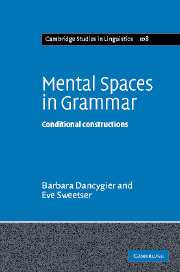Book contents
- Frontmatter
- Contents
- Acknowledgments
- Preface
- Note on abbreviated citations
- The door-scraper in the Wild Wood: an informal lesson in frame metonymy
- 1 Conditional constructions, mental spaces, and semantic compositionality
- 2 Prediction, alternativity, and epistemic stance
- 3 Tense, epistemic distance, and embedded spaces
- 4 Future and present forms in conditional constructions
- 5 Non-alternatives and alternatives: mental spaces in different domains
- 6 Then and even if: mental-space deixis and referential uniqueness
- 7 Clause order and space building: if, because, unless, and except if
- 8 Uniqueness and negative stance: only if and if only
- 9 Coordinate constructions and conditional meaning
- 10 The door-scraper in the Wild Wood: conditional constructions and frame-based space building
- References
- Author index
- Subject index
1 - Conditional constructions, mental spaces, and semantic compositionality
Published online by Cambridge University Press: 22 September 2009
- Frontmatter
- Contents
- Acknowledgments
- Preface
- Note on abbreviated citations
- The door-scraper in the Wild Wood: an informal lesson in frame metonymy
- 1 Conditional constructions, mental spaces, and semantic compositionality
- 2 Prediction, alternativity, and epistemic stance
- 3 Tense, epistemic distance, and embedded spaces
- 4 Future and present forms in conditional constructions
- 5 Non-alternatives and alternatives: mental spaces in different domains
- 6 Then and even if: mental-space deixis and referential uniqueness
- 7 Clause order and space building: if, because, unless, and except if
- 8 Uniqueness and negative stance: only if and if only
- 9 Coordinate constructions and conditional meaning
- 10 The door-scraper in the Wild Wood: conditional constructions and frame-based space building
- References
- Author index
- Subject index
Summary
“It makes me feel like I'm going to cry,” she said. “I can just imagine if it was my daughter.”
(Vancouver Sun, Oct. 4, 2000)[A woman comments on a reported case where a man assaulted a sleeping girl.]
Readers of the Vancouver Sun did not sit back and wonder what the speaker thought would have happened “if” her daughter had been the victim of such an assault. She did not have to present a then clause and describe the consequences explicitly. Not only were her actual hearers, and the eventual readers of the paper, able to build up the intended counterfactual situation (marked by the verb was); they were also presumably able to envision the likely emotional results on a victim's family. Furthermore, they surely recognized that the woman was not primarily expressing specific fear about her own daughter's safety, but empathy with the real-world victim and her mother. How did they do all this, prompted apparently only by the set-up of a situation where the speaker's daughter was imagined to be an assault victim?
Conditionals and conditional reasoning
There is something about if which engages the curiosity of the analyst. And rightly so: not only is the kind of reasoning manifested in a form such as imagine if it was my daughter an important aspect of human thought, but it also seems uniquely human to imagine in such detail scenarios which may be unreal and perhaps impossible (the speaker need not necessarily have a daughter in actuality), and to reason from them.
- Type
- Chapter
- Information
- Mental Spaces in GrammarConditional Constructions, pp. 4 - 27Publisher: Cambridge University PressPrint publication year: 2005



